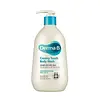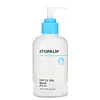What's inside
What's inside
 Key Ingredients
Key Ingredients

No key ingredients
 Benefits
Benefits

 Concerns
Concerns

 Ingredients Side-by-side
Ingredients Side-by-side

Water
Skin ConditioningCocamidopropyl Betaine
CleansingSodium Cocoyl Alaninate
Lauryl Glucoside
CleansingSodium Lauryl Glucose Carboxylate
CleansingTrihydroxystearin
Skin ConditioningPotassium Cocoyl Glycinate
Potassium Cocoate
EmulsifyingSodium Sweetalmondamphoacetate
CleansingChamaecyparis Obtusa Water
MaskingPanthenol
Skin ConditioningVitis Vinifera Seed Oil
EmollientButyrospermum Parkii Butter
Skin ConditioningMyristoyl/Palmitoyl Oxostearamide/Arachamide Mea
Skin ConditioningPhytosterols
Skin ConditioningCaprylic/Capric Triglyceride
MaskingCetearyl Alcohol
EmollientLecithin
EmollientSorbitan Stearate
EmulsifyingGlyceryl Stearate
EmollientStearic Acid
CleansingButylene Glycol
HumectantXanthan Gum
EmulsifyingGlycol Distearate
EmollientPolyquaternium-7
Sodium Chloride
MaskingHexylene Glycol
EmulsifyingCitric Acid
BufferingSodium Citrate
BufferingDisodium EDTA
1,2-Hexanediol
Skin ConditioningCaprylyl Glycol
EmollientSodium Benzoate
MaskingUndecylenic Acid
CleansingParfum
MaskingWater, Cocamidopropyl Betaine, Sodium Cocoyl Alaninate, Lauryl Glucoside, Sodium Lauryl Glucose Carboxylate, Trihydroxystearin, Potassium Cocoyl Glycinate, Potassium Cocoate, Sodium Sweetalmondamphoacetate, Chamaecyparis Obtusa Water, Panthenol, Vitis Vinifera Seed Oil, Butyrospermum Parkii Butter, Myristoyl/Palmitoyl Oxostearamide/Arachamide Mea, Phytosterols, Caprylic/Capric Triglyceride, Cetearyl Alcohol, Lecithin, Sorbitan Stearate, Glyceryl Stearate, Stearic Acid, Butylene Glycol, Xanthan Gum, Glycol Distearate, Polyquaternium-7, Sodium Chloride, Hexylene Glycol, Citric Acid, Sodium Citrate, Disodium EDTA, 1,2-Hexanediol, Caprylyl Glycol, Sodium Benzoate, Undecylenic Acid, Parfum
Water
Skin ConditioningDisodium Cocoyl Glutamate
CleansingDisodium Cocoamphodiacetate
CleansingPropanediol
SolventGlycerin
HumectantSodium Chloride
MaskingCoco-Glucoside
CleansingXanthan Gum
EmulsifyingSodium Sweetalmondamphoacetate
CleansingMyristoyl/Palmitoyl Oxostearamide/Arachamide Mea
Skin ConditioningSimmondsia Chinensis Seed Oil
EmollientHelianthus Annuus Seed Oil
EmollientVitis Vinifera Seed Oil
EmollientCarthamus Tinctorius Seed Oil
MaskingCamellia Sinensis Seed Oil
HumectantCentella Asiatica Extract
CleansingMadecassoside
AntioxidantCocodimonium Hydroxypropyl Hydrolyzed Wheat Protein
CleansingSodium Phytate
Citric Acid
BufferingSodium Citrate
BufferingHexylene Glycol
Emulsifying1,2-Hexanediol
Skin ConditioningCaprylyl Glycol
EmollientArtemisia Vulgaris Oil
PerfumingSantalum Album Oil
MaskingWater, Disodium Cocoyl Glutamate, Disodium Cocoamphodiacetate, Propanediol, Glycerin, Sodium Chloride, Coco-Glucoside, Xanthan Gum, Sodium Sweetalmondamphoacetate, Myristoyl/Palmitoyl Oxostearamide/Arachamide Mea, Simmondsia Chinensis Seed Oil, Helianthus Annuus Seed Oil, Vitis Vinifera Seed Oil, Carthamus Tinctorius Seed Oil, Camellia Sinensis Seed Oil, Centella Asiatica Extract, Madecassoside, Cocodimonium Hydroxypropyl Hydrolyzed Wheat Protein, Sodium Phytate, Citric Acid, Sodium Citrate, Hexylene Glycol, 1,2-Hexanediol, Caprylyl Glycol, Artemisia Vulgaris Oil, Santalum Album Oil
Alternatives
Ingredients Explained
These ingredients are found in both products.
Ingredients higher up in an ingredient list are typically present in a larger amount.
1,2-Hexanediol is a synthetic liquid and another multi-functional powerhouse.
It is a:
- Humectant, drawing moisture into the skin
- Emollient, helping to soften skin
- Solvent, dispersing and stabilizing formulas
- Preservative booster, enhancing the antimicrobial activity of other preservatives
Caprylyl Glycol is a humectant and emollient, meaning it attracts and preserves moisture.
It is a common ingredient in many products, especially those designed to hydrate skin. The primary benefits are retaining moisture, skin softening, and promoting a healthy skin barrier.
Though Caprylyl Glycol is an alcohol derived from fatty acids, it is not the kind that can dry out skin.
This ingredient is also used as a preservative to extend the life of products. It has slight antimicrobial properties.
Learn more about Caprylyl GlycolCitric Acid is an alpha hydroxy acid (AHA) naturally found in citrus fruits like oranges, lemons, and limes.
Like other AHAs, citric acid can exfoliate skin by breaking down the bonds that hold dead skin cells together. This helps reveal smoother and brighter skin underneath.
However, this exfoliating effect only happens at high concentrations (20%) which can be hard to find in cosmetic products.
Due to this, citric acid is usually included in small amounts as a pH adjuster. This helps keep products slightly more acidic and compatible with skin's natural pH.
In skincare formulas, citric acid can:
While it can provide some skin benefits, research shows lactic acid and glycolic acid are generally more effective and less irritating exfoliants.
Most citric acid used in skincare today is made by fermenting sugars (usually from molasses). This synthetic version is identical to the natural citrus form but easier to stabilize and use in formulations.
Read more about some other popular AHA's here:
Learn more about Citric AcidHexylene Glycol is a surfactant. Glycols are a class of alcohols. Hexylene Glycol is a surfactant and emulsifier.
As a surfactant, Hexylene Glycol helps gather dirt and oil on your skin to be washed away.
As an emulsifier, Hexylene Glycol helps keep water and oil together. This prevents them from separating in a product. Hexylene Glycol also thins out the texture of a product by lessening viscosity.
Hexylene Glycol has a small molecular weight.
Learn more about Hexylene GlycolWe don't have a description for Myristoyl/Palmitoyl Oxostearamide/Arachamide Mea yet.
Chances are, you eat sodium chloride every day. Sodium Chloride is also known as table salt.
This ingredient has many purposes in skincare: thickener, emulsifier, and exfoliator.
You'll most likely find this ingredient in cleansers where it is used to create a gel-like texture. As an emulsifier, it also prevents ingredients from separating.
There is much debate on whether this ingredient is comedogenic. The short answer - comedogenic ratings don't tell the whole story. Learn more about comegodenic ratings here.
The concensus about this ingredient causing acne seems to be divided. Research is needed to understand if this ingredient does cause acne.
Scrubs may use salt as the primary exfoliating ingredient.
Learn more about Sodium ChlorideSodium Citrate is the sodium salts of citric acid. In skincare, it is used to alter pH levels and acts as a preservative.
Its main functions are to maintain the pH of a product and neutralize metal ions.
The acidity of our skin is maintained by our glands and skin biome; normal pH level of skin is slightly acidic (~4.75-5.5).
Being slightly acidic allows our skin to create an "acid mantle". This acid mantle is a thin barrier that protects our skin from bacteria and contaminants.
Learn more about Sodium CitrateWe don't have a description for Sodium Sweetalmondamphoacetate yet.
Vitis Vinifera Seed Oil comes from the grape vine. Grape seeds are a byproduct of creating grape juice or wine.
The components of grape seeds have many skin benefits. Research has found it to be antimicrobial and anti-inflammatory. It also contains many potent antioxidants such as Vitamin E , Vitamin C, proanthocyanidins, polyphenols, flavonoids, and anthocyanins. Proanthocyanidin has been shown to help even out skin tone.
Antioxidants help fight free-radical molecules. Free-radical molecules are capable of damaging our cells and other genetic material. Antioxidants help stabilize free-radicals by donating extra electrons. Grape seed extract may help reduce the signs of aging.
The antimicrobial properties of grape seed may help treat acne. However, more research is needed to support this claim.
Grape seed has also been found to help absorb UV rays. Grape seed extract should not replace your sunscreen.
The fatty acids of grape seed oil give it emollient properties. Emollients help soothe and soften your skin by creating a film. This film traps moisture within, keeping your skin hydrated.
Learn more about Vitis Vinifera Seed OilWater. It's the most common cosmetic ingredient of all. You'll usually see it at the top of ingredient lists, meaning that it makes up the largest part of the product.
So why is it so popular? Water most often acts as a solvent - this means that it helps dissolve other ingredients into the formulation.
You'll also recognize water as that liquid we all need to stay alive. If you see this, drink a glass of water. Stay hydrated!
Learn more about WaterXanthan gum is used as a stabilizer and thickener within cosmetic products. It helps give products a sticky, thick feeling - preventing them from being too runny.
On the technical side of things, xanthan gum is a polysaccharide - a combination consisting of multiple sugar molecules bonded together.
Xanthan gum is a pretty common and great ingredient. It is a natural, non-toxic, non-irritating ingredient that is also commonly used in food products.
Learn more about Xanthan Gum